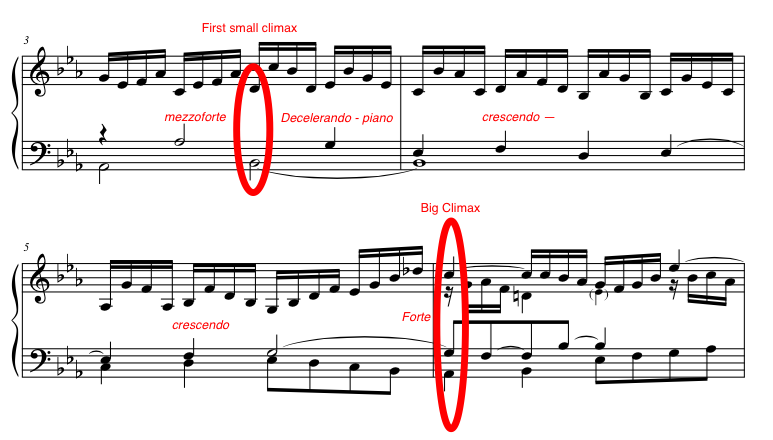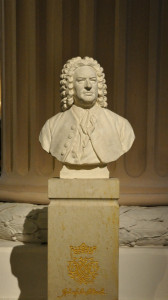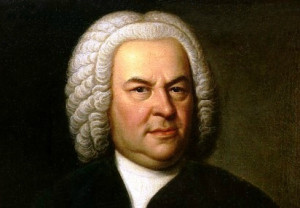The Allemande from Bach’s French Suite No. 4 is a relatively short piece, making its contrapuntal demands on the player quite manageable. This movement in E-flat Major, from BWV 815, does present some challenges with polyphony. However, as a musician with a background in harpsichord and piano, I present different ways of handling the contrapuntal sections for this article for GRAND PIANO PASSION™’s Classical Music Amplified™ series.
Voicing and Timing the Opening of the Allemande in Bach’s French Suite No. 4
The opening of the first half, set in the resonant tenor and bass of the instrument, invites a player of modest ability to coax a rich sound out of even a mediocre instrument. The Allemande opens with a beautiful wave of tenor, 16th notes in the right hand, underpinned by sustained bass notes in the left hand. The 16th notes slowly make their way up into the high soprano by measure 5, at which point Bach deftly transforms the texture into four-voice counterpoint. Although this opening is but five measures long, the pianist ought to give a convincing and musical account.
For the first three measures, the harmonies as well as left and right hand lines all steadily ascend to a small climax at the third beat of measure 3. With this simultaneous ascent, the inherent tension build-up is incredible. To articulate this on the piano, I suggest that the volume be slowly and carefully increased. Because the bass notes lie in a particularly resonant area of the instrument, I suggest beginning with a pianissimo volume and slowly crescendoing until you reach a mezzoforte at the D in the right hand and B-flat in the left hand. After hitting these notes, I suggest making a small decelerando and dropping the volume back to a piano and then slowly making a gradual crescendo again as you approach the big climax at measure 6, where the contrapuntal texture begins. Forte on the first beat of measure 6 is an appropriate way to show the climax and transition.
Balancing Strict Polyphony in the Bach French Suite No. 4
There’s a variety of possibilities to consider for this contrapuntal part of the piece that begins at measure 6. Before considering a couple of choices, I would suggest simply practicing this section of the piece (as well as the contrapuntal part of the second half of the piece, which begins at measure 13) hands separately many times. You need to become comfortable with sustaining a soprano note with your right-hand pinky, for example, and executing the alto voice with your other fingers. The left hand is a little less complicated in this regard, but I still suggest practicing it hands separate.
The first and very common way to handle the Allemande’s strict counterpoint is to play the soprano line so that it has more prominence than any of the other voices on the first time through. Then, on the repeat, the alto voice and sometimes the tenor as well, are played with the most prominence, while keeping the bass and soprano lines relatively reticent.
Another way to handle the counterpoint derives from the harpsichord. Instead of varying the volume in order to bring out different voices, the goal can be instead to strive for a truly equal volume for each voice. This is how the piece automatically sounds on the harpsichord, since you cannot vary volume by touch (although on the harpsichord, you can emphasize different voices by varying the rhythm).
To Pedal or Not to Pedal in Bach?
Using pedal on the piano in Bach is a needlessly controversial issue—I encourage you to experiment playing all Bach with and without pedal. Certainly, Bach with no pedal means that your fingers must do all the work of phrasing and legato, just as Bach and his contemporaries had to do on the harpsichord, clavichord, and organ. On the other hand, when Bach’s music is played on the harpsichord—particularly the Allemande of this French Suite—the instrument has a particular, sustained glow and resonance that can only be gotten on the piano with the use of pedal.
When using pedal in Bach, it is paramount to pedal in such a way that allows both the harmonies and contrapuntal passages to be clear and un-blurred. So in measures 1–5 and 11–12, you should change your pedal whenever the harmonies change. In the contrapuntal sections of the piece, if you decide to pedal in them at all, you will need to use a very shallow pedal and change your pedal very frequently. The opportunities for experimentation are boundless, and the more you experiment, the more you begin to hear what sections of a piece sound right with and without pedal.
The Origin of Bach’s French Suites
Bach wrote the French Suites during his time as chapel master for Prince Leopold of Anhalt-Cöthen. The first five suites are included in Bach’s 1722 Notebook of keyboard music for his wife, Anna Magdalena. In Bach’s autograph, the suites are simply titled Suites pour le Clavessin (suites for the harpsichord).
It’s unknown when the term French Suites began to be attached to the works, but the reason behind the attribution is sound. Bach’s French Suites, unlike the English Suites and the Partitas, mirrors the French harpsichord suites of 17th and 18th-century French harpsichord and lute composers. These “suites” or piéces, as the French simply referred to them, were highly stylized dance movements organized by key. Each was usually very short, lasting no more than one page.
In the contrapuntal sections of this Allemande, both the 16th notes in the right hand as well as the sustained bass notes in the left hand come directly out of the French harpsichord and lute music’s use of style brisé (broken style). With this device, the notes of harmonies are spread successively over the parts of a beat, as opposed to being lined up and played together as chords. The effect this has on both lute/guitar and harpsichord/piano is hypnotic, to say the least.
 look inside |
Bach — French Suites Composed by Johann Sebastian Bach (1685-1750). Edited by Judith K. Linder Schneider. For Piano. Masterworks; Piano Collection. Alfred Masterwork Edition. Form: Suite. Baroque; Masterwork. Advanced; Early Advanced; Intermediate; Late Intermediate. Book. 144 pages. Published by Alfred Music (AP.700C). |






0 Comments